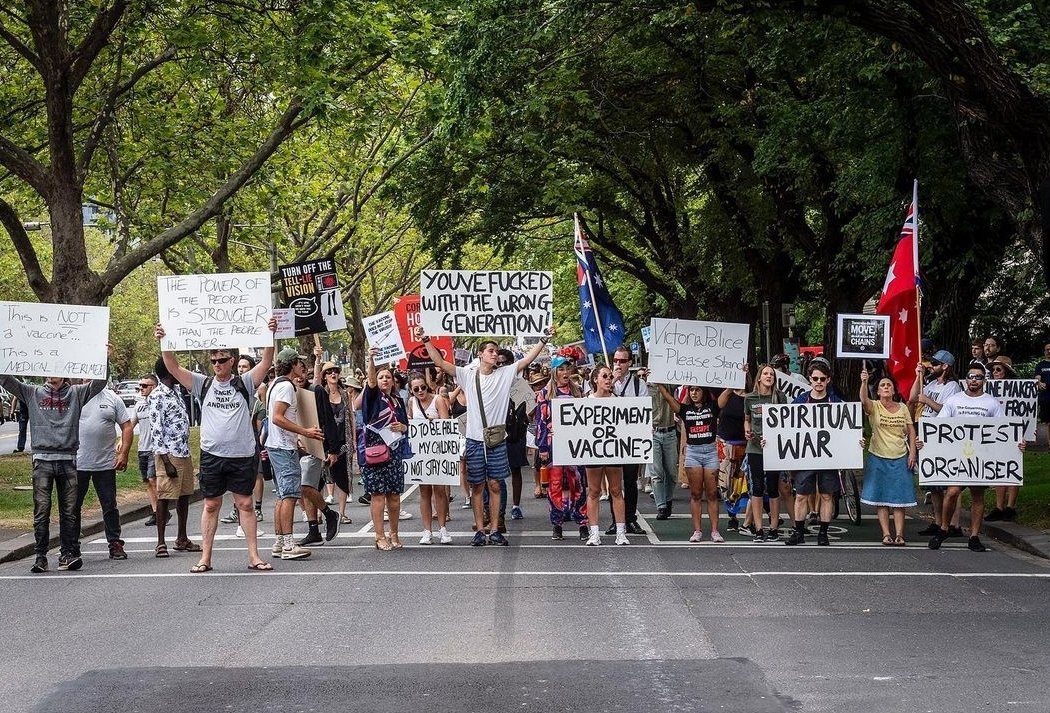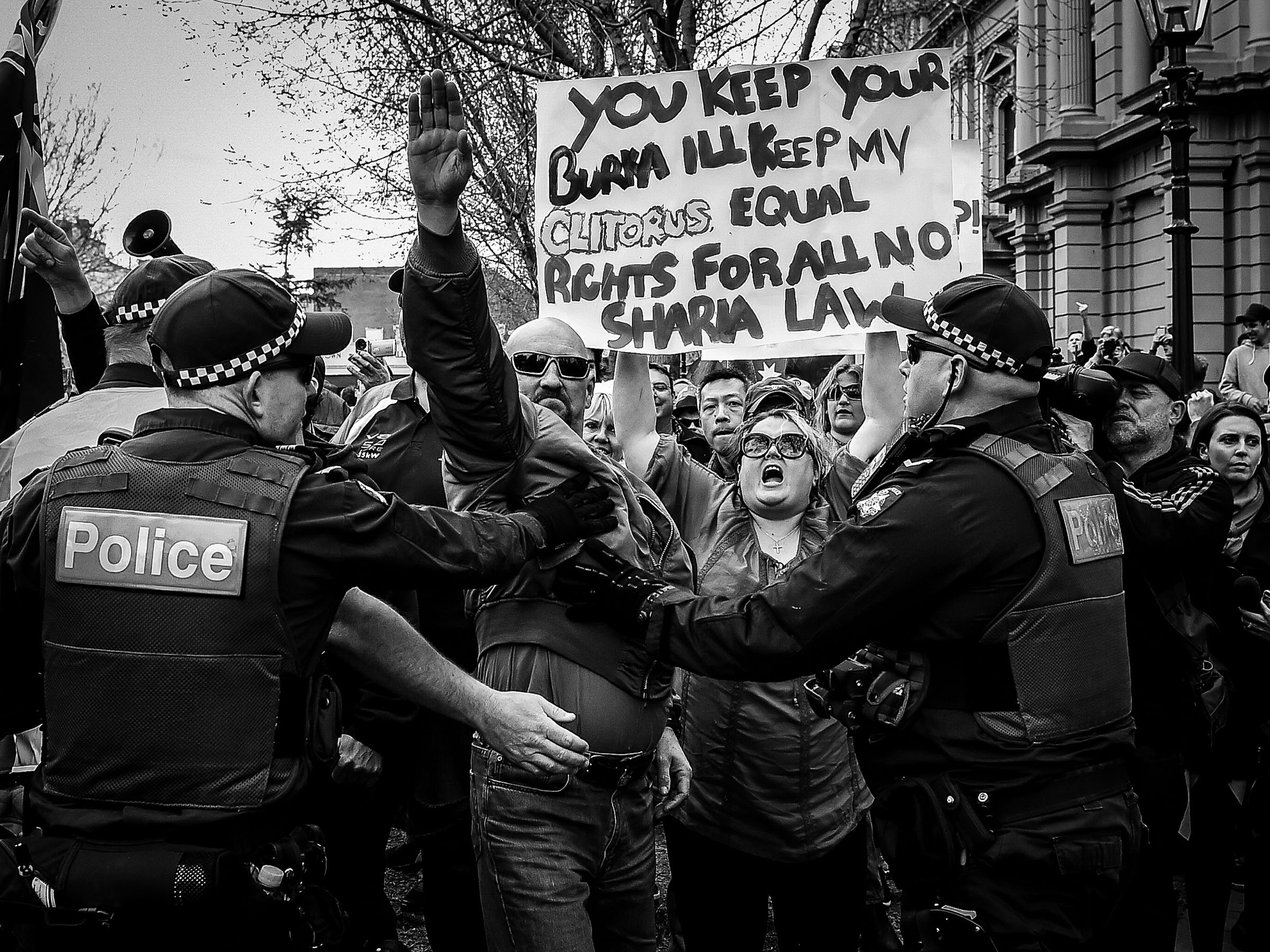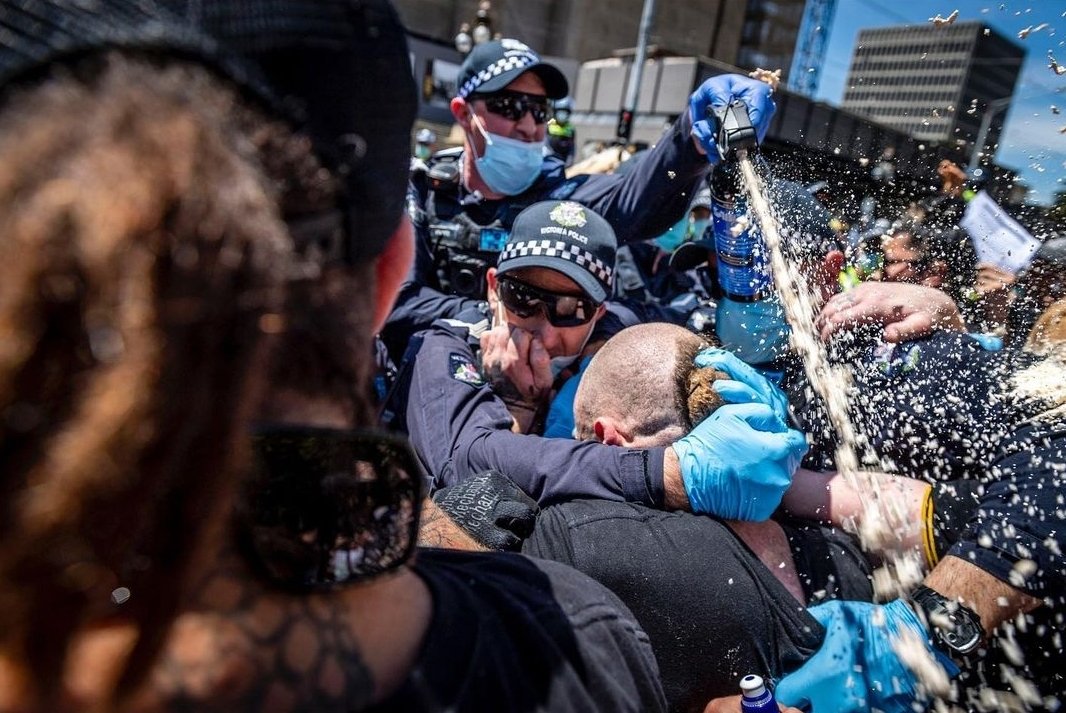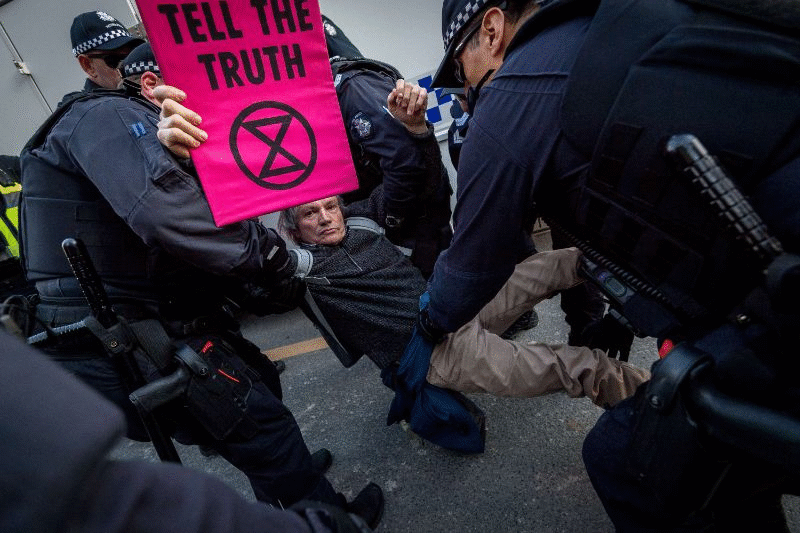The Victorian Police chief commissioner has flagged new protocols for handling media during protests, including the potential for a controversial police accreditation system, following the wrongful arrest of Herald Sun photographer, Jake Nowakowski.

Jake was arrested alongside Herald Sun reporter, Olivia Jenkins, on Saturday, February 20 during an anti-vaccine protest at Fawkner Park in Melbourne. Although they were released after 10 minutes, it’s uncommon for accredited media to be arrested when covering a newsworthy events, and sets a dangerous precedent regarding press freedom.
‘They are lawfully not allowed to use “move-on” powers on media, unless they see you as posing a threat, see you’re in danger, or believe you’re committing a crime,’ Jake told Inside Imaging. ‘It always depends on the individual police officer.’
Victoria Police issued a public apology and chief commissioner, Shane Patton, sent a personal letter of apology to Jake and Olivia.
‘Along with the apology he determined it (our arrest) was a big mistake. The police are going to change the way they approach media in these situations, and the offending officers will be heavily briefed on what to do and what not to do. They’re planning to look into a police accredited card system, which is interesting.’
While Jake’s grateful the police are apologetic and will treat media with more care, he’s concerned about whether an in-house police accreditation system may dictate who can and cannot cover a protest or demonstration.
‘What happens to the photography or journalism students who don’t have the accreditation because they’re shooting for a folio, or a freelancer,’ he said. ‘VicPol’s greatest concern is making it easier for officers to tell the difference between media and people part of the protest movement calling themselves media.’
In the public statement, Victoria Police highlighted an ‘increased number of protesters claim to be media’ to avoid arrest. Jake hasn’t noticed protesters running around with fake News Corp or Fairfax lanyards. He believes it’s the new alternative media figures who strongly support protest movements and carry their own media accreditation.
The accessibility of high-quality photography and video recording devices and the rise of online media outlets, including live streaming and YouTube channels, has led to the expansion of this alternative media landscape.
‘Lots of protesters are calling themselves journalists and carrying around accreditation who may work for an alternative media outlet. A lot of these people greatly sympathise with the movement, or are part of the movement. I think in that situation you’re either in the movement or reporting on it. There needs to be a separation.’
But addressing this matter with a police accreditation system isn’t so simple. Jake highlights a photographer, working for a little-known Hong Kong-based news agency, was arrested and fined last year when covering an anti-lockdown protest. The photographer wasn’t a protest sympathiser, and will fight the fine in court without support from his agency.
‘The only people helping him out, I think, are the MEAA [Media, Entertainment and Arts Alliance]. Will he be able to get one of these [accreditation] cards? And let’s say he was arrested, if he didn’t have one of these cards then would he have a chance of getting off in court? There are heaps of questions around what they’re proposing.’
Although the commissioner’s letter only made reference to exploring the viability of an accreditation system. It’s yet to be developed.
Photographing protests up close

Jake has been a staff photographer for the Herald Sun since 2013. When he was an aspiring photojournalist in the early 2000s, he would take days off work to cover protests. This played an important role in developing his skills, and his protest photos have gone on to win awards.
‘I find protests to be interesting environments to photograph, as they’re dynamic, fast-moving and forever changing,’ he said. ‘A lot of work I do for the Herald Sun is set up portrait-style photography, and I guess protests are the polar opposite of that. It’s also partly why I wanted to get into photojournalism – to shoot news events, and protests are a very raw representation of that. They can be exciting, and usually based on something that’s very topical in the present news cycle.’
Jake has closely follows protest movements swelling up in Melbourne since joining the Herald Sun. His coverage of the anti-immigration and alt-right movements, and their clashes with left-wing pro-refugee groups, was the subject of his solo exhibition, Neo Pride, shown at last year’s Head On International Photo Festival.
With the onset of Covid, the anti-immigration movement went into hiatus, and now the predominant protest cause is anti-lockdown/anti-mask/anti-vaccine.
‘What began as a very small, almost non-existent protest movement made up of a few anti-vaxxers in last year’s first lockdown blossomed into this quite large protest movement. Now there is an eclectic mix of people from all different walks of life. You get everyone from the alt-right Proud Boys to Qanon conspiracy theorists, anti-vaxxers, people from the wellness industry, church groups including some from the Pacific Islands, old people and young people.’
Attitudes toward media from protesters and police hasn’t really changed. Photographers and journalists, particularly from mainstream media outlets, have never been welcome. ‘The alt-right didn’t like us, the far-left didn’t like us either. And neither did the police. So we copped it from all sides.’
Prior to his arrest, Jake had never been marched off in handcuffs. During the protest he was caught in a police encirclement, a controversial tactic called ‘kettling’, where police tighten in on the group and special ops arrest individual protesters.
The photographer has been in a ‘kettle’ before, and it’s a high pressure situation. Ordinarily, he’d inform an officer he’s Herald Sun staff and will be let out. But sometimes they won’t allow him leave, and it’s a matter of going to the other side of the encirclement to ask another officer to release him. ‘It depends on the individual. Up until this point the police haven’t had a proper protocol to follow with media’.

But he’s had other fairly unpleasant experiences, including copping pepper spray directly in the face, being ‘manhandled’ by police and protesters, and threatened and abused more times than he can count. It’s naturally part of the job; getting a great shot requires Jake to get in close with a wide-angle lens.
Sometimes protests turn violent, especially when there aren’t any police around. Prior to their arrest, a woman verbally and physically attacked journalist, Olivia Jenkins, for wearing a face mask.
When the police arrive, it’s always handy to know where they are in relation to you and the protesters. ‘The only thing that’s going to save you from an angry mob, or individual protester, might be the police.’

Here is Jake’s advice to aspiring photojournalists attending protests:
I see lots of aspiring photographers, including photographic students, at protests. And I know a number of photographers who covered the alt-right movement and are now working as professionals.
My advice would be to keep shooting. Don’t stop doing what you’re doing – stay motivated. The only way to improve is to keep at it and look at other peoples’ work. Be informed of the movements, and remain informed of what’s happening within them.
In regards to staying safe, maybe take a pair of goggles to protect your eyes from pepper spray. Beyond the pain, it’s hard to see and if you can’t see you can’t take photos. Be mindful of who is around you. It’s important to read the crowd. A mob mentality can take over a crowd of people, and that’s when all rational thought is gone. Situations can change very quickly, so it’s important to read a crowd.
When the shit hits the fan, and you find yourself in a tricky situation where your adrenaline is running, you might get the shakes and go into that fight-or-flight mode. It’s important to stay calm. Slow down and try not to panic, so you can stay calm and collected. That’ll allow you to make rational decisions about whether you should get in closer, move away, or if there is someone after you and whether you’re in danger.
I’d avoid engaging with individuals from the protest movement too deeply. Having said that, if you cover a protest movement over a number of years, you’ll see the same faces and recognise a core group of people. Sometimes it’s beneficial to establish a relationship with a person or two. They’ll recognise you as well. But don’t engage too deeply, don’t share opinions. You have to remain objective.





Giving the police powers to approve or decline media accreditations is not only an attack on journalism, but an assault on the rights of all citizens. The implications of such a policy, as has apparently been proposed, is very concerning.
I do not quite understand what you mean by ‘Police Accreditation’. I worked from 1964 to 1984 as a photographer for ABCTV in Melbourne. I had a pink card from the Victorian Police saying that I was an official photographer for the Australian Broadcasting Commission (in those days)
and I was to be given every curtesy by the police. I had to have this renewed every so often.
Hey Richard,
My understanding is the police are considering the accreditation system directly for protests. I wasn’t made aware of any existing cards supplied to photographers by police. I wonder if the pink cards are still in circulation?
Cheers, Will
My understanding is that VicPol are looking into issuing a card which states that you are recognised as media by VicPol. I see a couple of potential issues with this. 1 – what happens to people who are well intentioned (photographic students or photographers without representation) and do not posses this card? Will they be targeted and subject to arrest? 2 – Will this card/accreditation encourage VicPolmto further micro manage media activities during protests? For example, will VicPol be inclined to try and dictate where VicPol accredited media will be able to shoot from? We’re already seeing this at crime scenes where police try and establish ‘media points’, sometimes stepping beyond such a point, even if it’s in a public place where other members of the public happen to be is not to their liking.
Agree wholeheartedly with Jake. VicPol aren’t to be trusted. This will be used against us in future by them.
Firstly, the photos of the “left-wing Extinction Rebellion” protest is incorrectly labelled. This was Blickade Imarc, which was a coalition if many groups. Extinction Rebellion pulled out of this coalition specifically because XR is explicitly non-violent, unlike some other groups. A correction would be greatly appreciated.
Secondly, it is perfectly acceptable for a journalist to have an ideological bent, and all the Kore so if they acknowledge it. There is a strong tradition of activist journalism that must be defended here.
Hello, I was hoping to cite this article as part of a student essay on protest photography. Who do I credit this page to? Thanks very much!
Hi Kylie. That would be the editor, Will Shipton. Cheers.
Thanks so much!
Like Richard Dutham’s Press pass, I too have had a pink Media pass issues by Vic Pol, which expired in 1986. It has sat connected to other accreditations when at the coal face of demonstrations, but has never been asked for or looked at by Vic Pol. Regardless of that, I have had my share of pepper spray and a rubber bullet.